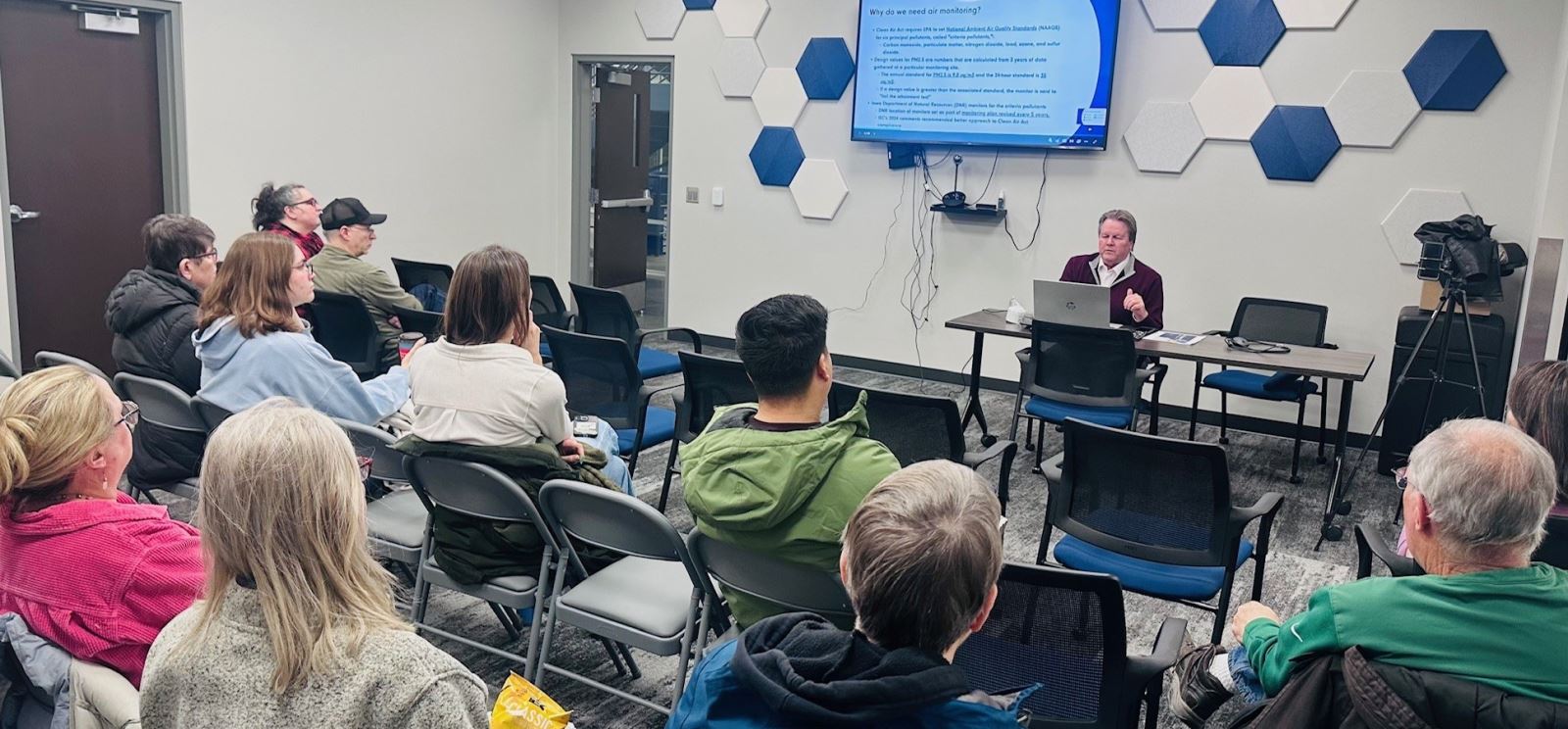Citizens of Siouxland take air pollution monitoring into their own hands
posted
on Tuesday, February 11, 2025

Siouxland residents gathered on January 23 to learn about the health impacts of air pollution in Woodbury County — and ways local people can take action to improve it and hold polluters accountable.
The event was hosted by the Iowa Environmental Council and Moms Clean Air Force, with the goal of empowering residents and policy makers with better data on the kinds of air pollution unique to the area. By installing air quality monitoring devices at the homes or businesses of local volunteers, the project will gather better data on the spread and concentration of pollution in Siouxland, including from the two coal-fired power plants operated near Sioux City by MidAmerican Energy, a private power monopoly and subsidiary of Berkshire Hathaway.
Why Do We Need Air Monitoring?
Air pollution can be challenging to identify because it is largely invisible. While people can recognize smoke billowing out of a tall stack at an industrial facility as pollution, the dense cloud quickly breaks up and disappears, making it easy to think the risk from pollution disappears as well. Unfortunately, this is not the case.

The George Neal coal-fired power plants, located near Sioux City
The Clean Air Act requires the US Environmental Protection Agency to set National Ambient Air Quality Standards (NAAQS) for six principal pollutants, called criteria pollutants: carbon monoxide, particulate matter, nitrogen dioxide, lead, ozone, and sulfur dioxide. Fine particulate matter (PM2.5) refers to microscopic particles less than 2.5 micrometers in diameter (100 times thinner than a human hair), which originate from industrial processes, emissions, and burning.
The Iowa Department of Natural Resources (DNR) tracks air pollutants as part of a monitoring plan revised every five years. In 2024, IEC submitted comments to the DNR recommending a better approach to Clean Air Act compliance, which included a more robust air monitoring system. Specifically, IEC requested that DNR expand its air monitoring network to include ozone and PM2.5 monitors in all areas with asthma rates higher than 80% of the national average. IEC also offered as an alternative recommendation that the DNR establish shorter-term Special Purpose Monitors to cover these areas of concern.
Power Plants and Pollution
Coal-burning power plants are a major source of fine particulate matter (PM2.5) as well as sulfur dioxide (SO2), nitrogen oxides (NOx), and mercury. PM2.5 emitted by coal plants is rich in SO2, black carbon, and metals, and is associated with increased risk of death from cardiovascular issues. When pregnant people and children are exposed to PM2.5, it can result in low birth weight, improper immune system development, impaired cognition, metabolic disorders, and asthma. Recent evidence from the National Institutes of Health suggest that coal emissions may be more deadly than PM2.5 from other sources.
In 2024, current air monitoring systems showed that MidAmerican Energy’s two Siouxland coal plants – George Neal 3 and 4 – produced 2,713 tons of SO2 and 1,433 tons NOx.
Coal plants are not the only source of PM2.5; in January, Iowa DNR fined Cargill Inc. $10,000 for exceeding hazardous air pollutant emission standards at its Sioux City feed mill, which still isn't in compliance and likely won't be for another year. As reported in the Des Moines Register:
Tests show that the nation's largest privately held business [Cargill] continues to exceed particulate matter emission standards on two of three cooler stacks at the [Iowa] facility. One test showed that fine particulate matter was 17 times the required limit and larger particulate matter was nearly six times the limit.
The new volunteer air monitoring initiative will better assess PM2.5 pollution levels in Siouxland so that corporate polluters like MidAmerican Energy and Cargill can be held accountable.
(1).png)
Citizen Air Monitoring Initiative
At the January 23 event, experts with IEC and Moms Clean Air Force shared information about how pollution from the coal plants is affecting the health of Siouxland residents and that the Iowa DNR isn’t doing enough to monitor toxic pollution in the community. Attendees also learned about an opportunity to participate in citizen air monitoring in Siouxland. This project will involve installation of air monitoring devices at sites around the community, such as homes, businesses, schools, and churches. The monitors will operate 24/7 and report PM2.5 data to a public website that allows residents, experts, and policymakers to see spikes in air pollution and trends over time at various locations in the region. With the data collected by this network, residents will have a critical tool for advocating to the state and local governments for regulations that better protect the health of people in Siouxland.
If you live in or around Sioux City and you want to hear more about this initiative or become a volunteer air quality monitor, contact Lexi McKee-Hemenway, Campaign Organizer in Sioux City for IEC, at mckee-hemenway@iaenvironment.org.